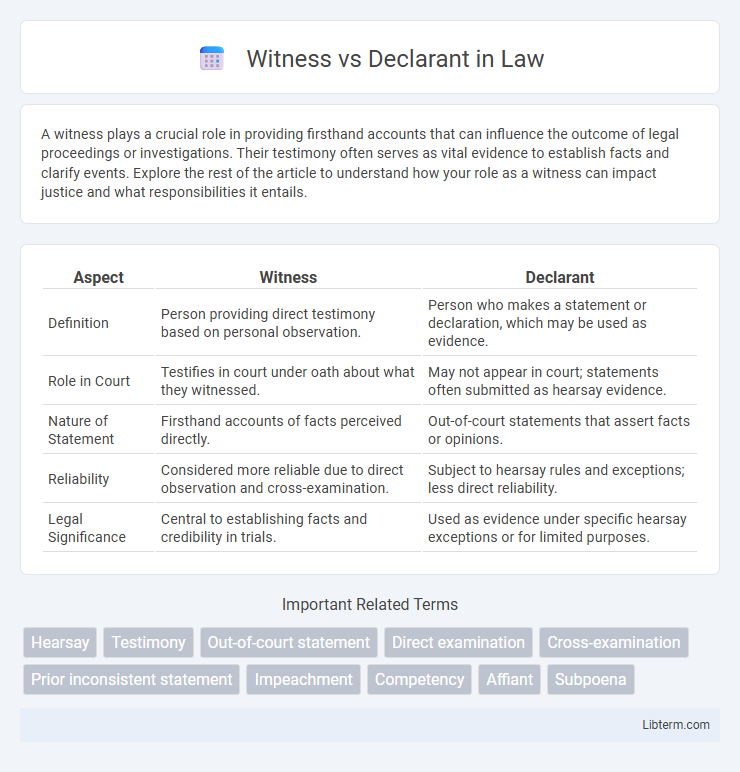A witness plays a crucial role in providing firsthand accounts that can influence the outcome of legal proceedings or investigations. Their testimony often serves as vital evidence to establish facts and clarify events. Explore the rest of the article to understand how your role as a witness can impact justice and what responsibilities it entails.
Table of Comparison
| Aspect | Witness | Declarant |
|---|---|---|
| Definition | Person providing direct testimony based on personal observation. | Person who makes a statement or declaration, which may be used as evidence. |
| Role in Court | Testifies in court under oath about what they witnessed. | May not appear in court; statements often submitted as hearsay evidence. |
| Nature of Statement | Firsthand accounts of facts perceived directly. | Out-of-court statements that assert facts or opinions. |
| Reliability | Considered more reliable due to direct observation and cross-examination. | Subject to hearsay rules and exceptions; less direct reliability. |
| Legal Significance | Central to establishing facts and credibility in trials. | Used as evidence under specific hearsay exceptions or for limited purposes. |
Definition of Witness and Declarant
A witness is an individual who observes an event or occurrence firsthand and provides testimony based on their direct sensory experience during legal proceedings. A declarant, by contrast, is a person who makes a statement or declaration outside of court, which may later be presented as evidence, often through hearsay exceptions. Understanding the distinction between a witness and a declarant is crucial for determining admissibility and weight of evidence in civil and criminal cases.
Key Differences Between Witness and Declarant
A witness provides firsthand testimony based on their direct observation or involvement in an event, whereas a declarant is the person who makes a statement or declaration, which may be relayed by another party. Witness testimony is typically subject to cross-examination in court, while a declarant's statements can be considered hearsay unless they fall under specific exceptions. The key distinction lies in the source of information: witnesses relay what they directly perceived, and declarants offer assertions that may be secondhand or recorded.
Roles in Legal Proceedings
A witness provides firsthand testimony based on direct observation or experience relevant to the case, offering evidence under oath during legal proceedings. A declarant is an individual whose out-of-court statement is introduced as evidence, often through hearsay exceptions, without the need for live testimony. Understanding these distinct roles is crucial for applying evidentiary rules and assessing the credibility and admissibility of statements in court.
Types of Testimony: Direct vs Hearsay
Witness testimony involves firsthand accounts where the individual directly observed or experienced the event, providing direct evidence under oath. Declarant testimony refers to statements made outside the courtroom, which are introduced as evidence and classified as hearsay unless they meet specific legal exceptions. Understanding the distinction between direct testimony by witnesses and hearsay statements by declarants is essential for evaluating the admissibility and reliability of evidence in legal proceedings.
Legal Relevance of Each Role
A witness provides direct testimony based on personal observation or experience relevant to the facts of a case, making their role crucial for establishing evidence. A declarant, on the other hand, is the source of a statement used as evidence, often in hearsay situations, where the legal relevance hinges on exceptions to hearsay rules. Understanding the distinction ensures proper admissibility and weight of testimony in legal proceedings.
Rights and Responsibilities of Witnesses
Witnesses have the right to be informed about the nature of the case and to receive protection from intimidation or harm. They have the responsibility to provide accurate, truthful testimony based on their firsthand knowledge without speculation. Failure to fulfill these duties may result in legal consequences such as charges of perjury or contempt of court.
Admissibility of Declarations in Court
In court, a declarant is the individual who originally makes a statement, while a witness testifies to that statement or other facts based on personal knowledge. The admissibility of declarations depends on whether the statement qualifies as an exception to the hearsay rule, such as present sense impressions or excited utterances. Courts rigorously evaluate the circumstances under which the declaration was made to determine its reliability and whether it can be admitted as evidence.
Impact on Evidence and Verdicts
The distinction between a witness and a declarant significantly impacts evidence admissibility and verdict outcomes in legal proceedings. A witness provides direct testimony under oath, subject to cross-examination, enhancing the evidence's reliability and influencing juror credibility assessments. In contrast, a declarant's out-of-court statements may face hearsay objections, potentially limiting their evidentiary value and affecting the weight assigned by judges or juries in determining verdicts.
Common Misconceptions
Witness and declarant are often mistakenly considered interchangeable in legal contexts, but they serve distinct roles: a witness testifies based on personal observation, while a declarant provides a statement regardless of direct involvement. A common misconception is assuming all declarants appear in court, when many declarants' statements are introduced as hearsay exceptions without in-person testimony. Clarifying this distinction prevents errors in evidence handling and ensures accurate application of rules like those in the Federal Rules of Evidence.
Practical Examples and Case Studies
A witness provides firsthand testimony based on their direct observation or experience, such as an eyewitness describing a car accident they saw, while a declarant offers statements made outside court, like a victim's prior statement to the police used to establish facts without the declarant present. In cases like Crawford v. Washington, the Supreme Court emphasized the confrontation clause, limiting the use of testimonial declarant statements without cross-examination, affecting how courts treat hearsay evidence. Practical examples include police officers reading out-of-court witness statements during trial, which may be challenged unless the declarant is available for cross-examination, distinguishing real-time witness testimony from reported declarations.
Witness Infographic

 libterm.com
libterm.com